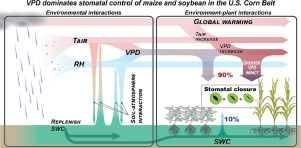当前位置:
X-MOL 学术
›
Agric. For. Meteorol.
›
论文详情
Our official English website, www.x-mol.net, welcomes your
feedback! (Note: you will need to create a separate account there.)
Redefining droughts for the U.S. Corn Belt: The dominant role of atmospheric vapor pressure deficit over soil moisture in regulating stomatal behavior of Maize and Soybean
Agricultural and Forest Meteorology ( IF 5.6 ) Pub Date : 2020-06-01 , DOI: 10.1016/j.agrformet.2020.107930 Hyungsuk Kimm , Kaiyu Guan , Pierre Gentine , Jin Wu , Carl J. Bernacchi , Benjamin N. Sulman , Timothy J. Griffis , Changjie Lin
Agricultural and Forest Meteorology ( IF 5.6 ) Pub Date : 2020-06-01 , DOI: 10.1016/j.agrformet.2020.107930 Hyungsuk Kimm , Kaiyu Guan , Pierre Gentine , Jin Wu , Carl J. Bernacchi , Benjamin N. Sulman , Timothy J. Griffis , Changjie Lin

|
Abstract The U.S. Corn Belt, the world's biggest production region for corn and soybean combined, is prone to droughts. Currently 92% of the U.S. Corn Belt croplands are rainfed, and thus are sensitive to interannual climate variability and future climate change. Most prior studies identify the lack of soil moisture as the primary cause of agricultural drought impacts, although water-related stresses are also induced by high atmospheric water demands (i.e., vapor pressure deficit, VPD). Here we empirically attributed the variability of canopy-level stomatal conductance (Gs) and gross primary productivity (GPP) to VPD and soil water supply (i.e. volumetric soil water content, SWC), using eddy-covariance data from seven AmeriFlux eddy covariance sites in maize and soybean fields across the U.S. Corn Belt, which are well represented for the current rainfed part of the Corn Belt croplands. We used three independent approaches, including two statistical models (i.e. a multiple-linear regression model and a semi-empirical, non-linear model) and information theory, to quantify the relationship of Gs (or GPP) with VPD and SWC. The attribution result from the two models shows that VPD explains most of Gs variability (91% and 89%, respectively), and mutual information also attributed 91% of GPP variability to VPD. This finding was robust over the gradients of rainfall and temperature, crop types (maize vs. soybean), and management practices (whether irrigated or not). We reconciled our finding with the previously emphasized importance of precipitation and SWC, by conducting a path analysis, which revealed the causal relationships between precipitation, air temperature (Ta), relative humidity (RH), VPD, SWC, and Gs. We find that precipitation impacts on Gs through reduced RH and Ta to VPD (rather than directly through SWC). With increased VPD robustly projected under climate change, we expect increased crop water stress in the future for the U.S. Corn Belt.
中文翻译:

重新定义美国玉米带的干旱:大气蒸气压不足对土壤水分的影响在调节玉米和大豆气孔行为中的主导作用
摘要 美国玉米带是世界上最大的玉米和大豆产区,容易发生干旱。目前,美国玉米带 92% 的农田都是雨养的,因此对年际气候变化和未来的气候变化很敏感。大多数先前的研究将缺乏土壤水分确定为农业干旱影响的主要原因,尽管与水相关的压力也由高大气需水量(即蒸气压不足,VPD)引起。在这里,我们根据经验将冠层气孔导度 (Gs) 和总初级生产力 (GPP) 的可变性归因于 VPD 和土壤供水(即土壤体积含水量,SWC),使用来自 7 个 AmeriFlux 涡流协方差点的涡流协方差数据美国玉米带的玉米和大豆田,这很好地代表了玉米带农田目前的雨养部分。我们使用了三个独立的方法,包括两个统计模型(即多元线性回归模型和半经验非线性模型)和信息论,来量化 Gs(或 GPP)与 VPD 和 SWC 的关系。两个模型的归因结果表明,VPD 解释了大部分 Gs 变异性(分别为 91% 和 89%),互信息也将 91% 的 GPP 变异性归因于 VPD。这一发现在降雨量和温度梯度、作物类型(玉米与大豆)和管理实践(无论是否灌溉)方面都是可靠的。通过进行路径分析,我们将我们的发现与之前强调的降水和 SWC 的重要性相协调,该分析揭示了降水之间的因果关系,空气温度 (Ta)、相对湿度 (RH)、VPD、SWC 和 Gs。我们发现降水通过将 RH 和 Ta 降低到 VPD(而不是直接通过 SWC)对 Gs 产生影响。随着气候变化下 VPD 增加的强劲预测,我们预计美国玉米种植带未来的作物水分压力会增加。
更新日期:2020-06-01
中文翻译:

重新定义美国玉米带的干旱:大气蒸气压不足对土壤水分的影响在调节玉米和大豆气孔行为中的主导作用
摘要 美国玉米带是世界上最大的玉米和大豆产区,容易发生干旱。目前,美国玉米带 92% 的农田都是雨养的,因此对年际气候变化和未来的气候变化很敏感。大多数先前的研究将缺乏土壤水分确定为农业干旱影响的主要原因,尽管与水相关的压力也由高大气需水量(即蒸气压不足,VPD)引起。在这里,我们根据经验将冠层气孔导度 (Gs) 和总初级生产力 (GPP) 的可变性归因于 VPD 和土壤供水(即土壤体积含水量,SWC),使用来自 7 个 AmeriFlux 涡流协方差点的涡流协方差数据美国玉米带的玉米和大豆田,这很好地代表了玉米带农田目前的雨养部分。我们使用了三个独立的方法,包括两个统计模型(即多元线性回归模型和半经验非线性模型)和信息论,来量化 Gs(或 GPP)与 VPD 和 SWC 的关系。两个模型的归因结果表明,VPD 解释了大部分 Gs 变异性(分别为 91% 和 89%),互信息也将 91% 的 GPP 变异性归因于 VPD。这一发现在降雨量和温度梯度、作物类型(玉米与大豆)和管理实践(无论是否灌溉)方面都是可靠的。通过进行路径分析,我们将我们的发现与之前强调的降水和 SWC 的重要性相协调,该分析揭示了降水之间的因果关系,空气温度 (Ta)、相对湿度 (RH)、VPD、SWC 和 Gs。我们发现降水通过将 RH 和 Ta 降低到 VPD(而不是直接通过 SWC)对 Gs 产生影响。随着气候变化下 VPD 增加的强劲预测,我们预计美国玉米种植带未来的作物水分压力会增加。











































 京公网安备 11010802027423号
京公网安备 11010802027423号